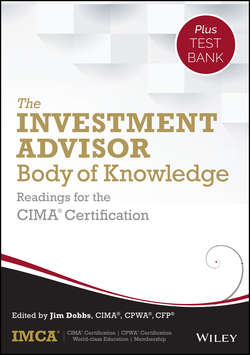Читать книгу The Investment Advisor Body of Knowledge + Test Bank - IMCA - Страница 17
На сайте Литреса книга снята с продажи.
CHAPTER 2
Regulatory Considerations
ОглавлениеInvestment advisors and consultants are subject to numerous laws and regulations that apply to the activities in which they engage, the products and services they provide, and the relationships they have with specific clientele they serve. Depending on these activities, products and services, relationships, and the jurisdictions in which they work, investment professionals may be subject to oversight by the following regulators: the SEC (Securities and Exchange Commission), FINRA (Financial Industry Regulatory Authority), and state securities boards or agencies among others.
This chapter explores fiduciary responsibilities, direct and indirect relationships, the principal-agent relationship, disqualified persons, prohibited transactions, and various laws and regulations that apply to investment advisors and consultants.
Learning Objectives
■ Define the term “fiduciary” and describe the fiduciary responsibility of CIMA® designees.
■ Describe the principal-agent relationship between investment professionals and individuals, trusts, foundations, endowments, and ERISA plan clients.
■ Identify circumstances that may cause a person to be identified as a fiduciary.
■ Describe laws that apply to investment advisors and consultants, including:
ERISA (Employee Retirement Income Security Act)
UPIA (Uniform Prudent Investor Act)
UMIFA (Uniform Management of Institutional Funds Act)
UPMIFA (Uniform Prudent Management of Institutional Funds Act)
Other international, federal, and state laws
■ Identify prohibited transactions.
In the client relationship, a consultant often is identified as a fiduciary or is said to have a fiduciary duty owed to the client. The term fiduciary can have a variety of meanings to clients and consultants. In general, a fiduciary duty, or capacity, can be defined as an ethical relationship between a consultant and a client in which the consultant is to act on behalf of and always in the best interest of the client. In turn, the client places trust and good faith in the consultant. The sole purpose of this relationship must be to safeguard the interests of the client at all times. Additionally, a fiduciary must adhere to a process that is deemed to be prudent.
The fiduciary relationship for a consultant and client can be established with individuals, trusts, foundations, endowments, ERISA plans, and many other circumstances. In each case, certain duties are expected to be performed at a minimum on behalf of the client or clients.
For individuals and trusts, the fiduciary has a responsibility to manage investments prudently. The Prudent Man Rule or the Prudent Investor Rule may apply in such cases. Although the rule is almost 200 years old and based on the Harvard College v. Amory case of 1830, it still is considered the foundation for most fiduciary relationships.
The rule states that trustees are directed to “observe how men of prudence, discretion, and intelligence manage their own affairs, not in regard to speculation, but in regard to the permanent disposition of their funds, considering the probable income, as well as the probable safety of the capital to be invested.” Trustees are to exercise care and skill in the selection of investments.
The initial Prudent Man Rule focused primarily on the merits of the individual investments, did not allow for risky investments, and focused on investments in government securities. Over time, interpretation of the rule evolved, with large steps taking place after the Great Depression and after World War II.
The more modern Prudent Investment Rule incorporates the theory of diversification and allows for overall portfolio management as the guiding principle for astute investment management.
Trustees are considered to be fiduciaries to the beneficiaries. Legally, an account or property is committed to the trustee. A beneficiary has no legal title to the trust, but has a beneficial use or interest. In this relationship, the trustee must only act in the interest of the beneficiary, and can in no way act in his or her own best interest.
With foundations, endowments, and ERISA plans, a board of directors may be held to the same fiduciary standards as a trustee. A major difference is the board's capacity to act in the interest of an entity, or in some cases, a large group of individuals. In many cases, the entities or individuals have legal title or claim to assets that the board is managing on their behalf. The decisions may be on a different scale, but the core principal of the fiduciary relationship remains intact.
Another term for the relationship is the principal-agent relationship. In a trustee relationship, the principal is the beneficiary, the person who is owed the duty, while the agent would be the trustee, the person who is the fiduciary. Other examples of the principal-agent relationship include company-board of directors, client-consultant, and heirs-executors.
A consultant may be considered a fiduciary under a number of different circumstances. In most cases, as a fiduciary, the consultant must apply fiduciary standards and exercise those standards with care. Some cases are obvious and others are by default.
